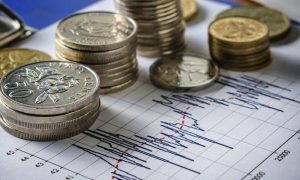SINGAPORE: The Singapore economy expanded at a faster-than-expected 1.8 per cent on a year-on-year basis in the final three months of 2016, according to advance estimates released by the Ministry of Trade and Industry (MTI) on Tuesday (Jan 3).
This was more than the revised 1.2 per cent growth in the third quarter.
 On a quarter-on-quarter seasonally-adjusted basis, gross domestic product (GDP) grew 9.1 per cent, marking a reversal from the 1.9 per cent contraction in the July to September period and dodging a technical recession defined as two straight quarters of declines in economic output.
On a quarter-on-quarter seasonally-adjusted basis, gross domestic product (GDP) grew 9.1 per cent, marking a reversal from the 1.9 per cent contraction in the July to September period and dodging a technical recession defined as two straight quarters of declines in economic output.
Analysts have earlier put forth expectations for the economy to avert a technical recession, following a jump in industrial production in November. Economists surveyed by Reuters had forecast Singapore’s fourth-quarter GDP to grow 3.7 per cent from the previous three months on an annualised basis and 0.6 per cent on a year-on-year basis.
This quicker-than-expected pace of growth brought full-year GDP growth to 1.8 per cent, above the Government’s forecast for 2016 growth to be between 1.0 and 1.5 per cent.
However, this marks Singapore’s weakest annual rate of growth since 2009, when the economy was hit by the global financial crisis and shrank 0.6 per cent. Last year, the economy grew 2 per cent.
STRONG MANUFACTURING, SERVICES PROPPED UP GROWTH
Strong improvements in the manufacturing and services sectors helped to underpin growth in the final quarter of 2016.
The manufacturing sector, which makes up a fifth of Singapore’s economy, expanded 6.5 per cent on a year-on-year basis, way higher than the 1.7 per cent growth in the previous quarter. Growth was primarily driven by the electronics and biomedical manufacturing clusters, even as the transport engineering and general manufacturing clusters continued to contract, MTI said.
Compared to the previous three months on a seasonally-annualised basis, the sector grew by 14.6 per cent in the fourth quarter, marking a sharp turnaround from the 8.1 per cent contraction in the July to September period.
Growth in the services producing industries came in at 0.6 per cent from a year ago, slightly faster than the 0.3 per cent growth in the previous quarter. Support came from the “other services industries”, transportation & storage and business services sectors, according to the Trade Ministry.
On a quarter-on-quarter basis, the services producing industries staged a massive rebound with expansion at an annualised rate of 9.4 per cent, a reversal from the 0.4 per cent contraction in the third quarter.
“The services sector has officially ended its technical recession,” said a note from DBS, following the data release. “Accounting for about two-third of GDP and employment, this sector has always been the main driver of the economy. And as mentioned in many of our past writings, if the services sector turns, the economy turns along with it.”
The construction sector was the sole underperformer during the October to December period, with a contraction of 2.8 per cent on a year-on-year basis, extending the 0.2 per cent decline in the previous quarter. The contraction was largely due to the decline in private sector construction activities, MTI said.
However, on a quarter-on-quarter seasonally-adjusted annualised basis, the sector shrank by 4.7 per cent, moderating from the 14.8 per cent contraction in the preceding quarter.
STILL WARY OF ECONOMY’S OUTLOOK IN 2017: ANALYSTS
But moving forward, the outlook for Singapore’s economy remains cloudy.
Describing the fourth-quarter numbers as “a bit too good to be true”, Nomura economist Brian Tan said he is cautious over the sustainability of the GDP figures given the host of external and domestic downside risks that lie ahead.
For one, economic growth worldwide continues to be anaemic and global trade is shrouded with uncertainty as the United States threatens to embrace a protectionist stance on trade under President-elect Donald Trump.
Over in Europe, geopolitical risks continue to linger, with elections due in Germany and France and as Britain proceeds with its exit from the European Union. “We will likely get more clarity on Brexit this year and if things appear to be moving towards a hard Brexit, that could take a toll on global sentiment and Singapore won’t be spared,” Mr Tan said.
Meanwhile, a growth slowdown persists in China as the world’s second-biggest economy transitions from an export-driven to a consumption-driven model. With China being a major trading partner of Singapore, the continued moderation in growth figures which translates into diminishing demand, will be keenly eyed, Phillip Futures’ investment analyst Woon Tian Yong told Channel NewsAsia.
Back home, downside risks such as a weak property market, ongoing economic restructuring efforts and rising local interest rates given the US Federal Reserve’s indication for more aggressive rate hikes this year will likely continue to weigh on growth, analysts said.
“The Monetary Authority of Singapore’s (MAS) managed exchange rate regime ties interest rates in Singapore fairly closely to the Fed funds rate. Higher borrowing costs are likely to weigh on household and business spending, weaken the housing market further and dampen construction activity,” Capital Economics’ Krystal Tan said.
For 2017, Mr Tan from Nomura is predicting Singapore’s economic growth to come in at 0.7 per cent, way below the Government’s forecast for growth to be between 1 and 3 per cent.
Ms Selena Ling, OCBC Bank’s head of treasury research & strategy, expects next year’s GDP growth to be rangebound at around 1 to 2 per cent.
“The tide is gradually turning for 2017, with the long-awaited domestic manufacturing recovery finally taking root,” Ms Ling said. “However, the 2017 outlook remains tentative … amid key uncertainties like the Trump presidency potentially having spillover effects for global trade, China’s slowdown, and heightened market volatility, especially on the currency and interest rate front, potentially weighing on corporate and consumer confidence.”